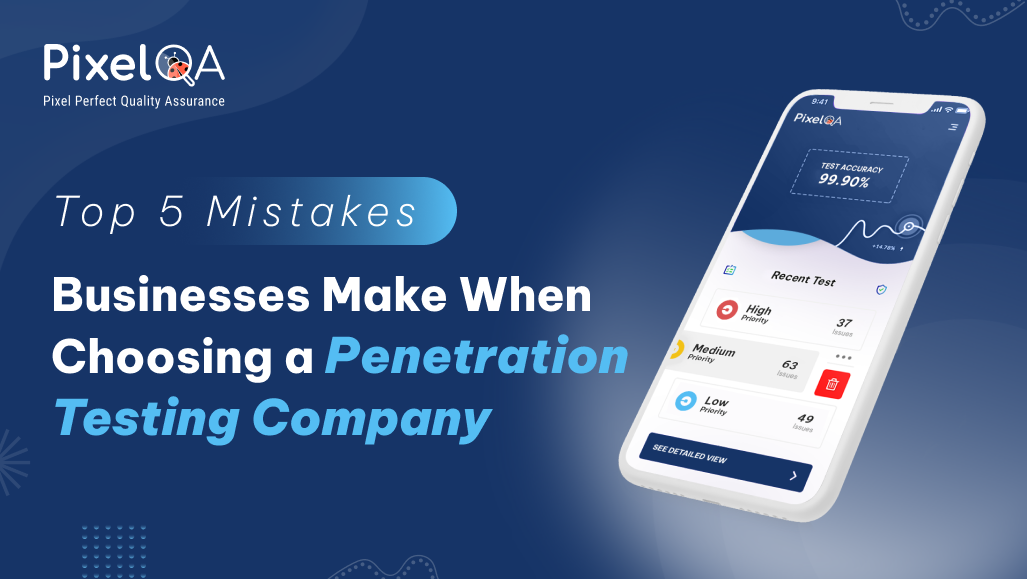
In our hyper-connected world, cybersecurity isn't a luxury, it's a necessity. One of the most important aspects of any proactive cybersecurity strategy is penetration testing (or pen testing). Penetration testing is where ethical hackers emulate attacks against your systems to find vulnerabilities before real malicious attackers do. Entering the market of pen testing is easy, but not all companies are equal. Selecting the wrong vendor means wasted budgets, false confidence, and in some circumstances compliance failures.
Businesses often rush the vendor onboarding and selection process, make expensive mistakes, and might not know it until an event happens and even worse, a breach.
In this blog, we will discuss the five most common mistakes businesses make when selecting a penetration testing company and the way you can avoid each one to protect your systems, data, and reputation.
Mistake #1: Prioritizing Cost Over Quality
The problem: Many organizations tend to worry about the cost and they will select the lowest cost provider without considering the depth of the service provided. Penetration testing is a field with specialists that requires skill, experience, knowledge of the changing threat landscape, etc. A bargain vendor may deliver generic scan reports with limited actionable advice.
The fix: Change your focus from "cost" to "value". Assess vendors according to their approach, expertise, and outputs. Look at testing depth, request sample reports, and seek out organisations with professional certifications (e.g., OSCP, CREST, CEH). You can spend a little extra on a project based on some expertise that may save you millions of dollars in the future.
Mistake #2: Not Verifying Methodologies and Standards
The problem: Some employers neglect to examine the testing methods used by vendors. Without an organized method of testing, tests can vary in execution, be incomplete or not applicable to your actual threat surface. Even worse, some companies perform nothing more than vulnerability scans and call them pen tests.
The fix: Be open and transparent. A good vendor should follow industry-recognized frameworks such as OWASP, PTES (Penetration Testing Execution Standard), or NIST guidelines. Request a definitive explanation of their testing process (phases) - planning, discovery, exploit, post-exploitation, reporting. This will ensure their results are reproducible, defensible, and thorough in any compliance audit.
Mistake #3: Ignoring Industry Experience and Specialization
The problem: Cybersecurity threats differ widely across industries. A pen tester with experience in fintech may not have the requisite skills to deal with the non-negotiable challenges in a healthcare or industrial IoT environment. However, we often see organizations engage contractors with generic firms that have no industry-specific domain knowledge.
The fix: Select a provider with experience in your area. Ask them to provide client references or case studies from the same types of industries. Knowledge of your environment helps testers identify more subtle vulnerabilities than generalists can and guarantees your bases are covered in terms of industry regulations (e.g. HIPAA, PCI-DSS, ISO 27001).
Mistake #4: Overlooking Reporting Quality and Post-Test Support
The problem: A penetration test is only as valuable as the results are valuable, and the results hinge on actionable reporting. Some vendors provide vague and technical reporting that does not enable internal teams to process findings or to remediate. Others vanish informally right after the report is sent, and there is no support or elaboration.
The fix: Before signing a contract, ask for a sample report. Look for clarity, risk ranking, and remediation details. Also, see if they offer a debrief or consultation after the test ends. Good partners don't just deliver findings and assume you're good to go; they help you understand and remediate.
Mistake #5: Treating Pen Testing as a One-Time Activity
The problem: Companies tend to view penetration testing as a checkbox task, something to be accomplished annually for compliance and then forgotten. Threats change daily, fresh code is released every week, and yesterday's secure application can be today's weakness.
The fix: Embed penetration testing into your larger security lifecycle. Look for partners like a trusted penetration testing company who offer ongoing evaluations, retesting, and responsive solutions across changing threat profiles. Look at forming long-term alliances with providers that are familiar with your business, systems, and goals as such.
What to Look for in a Pen Test Partner
- Certifications: Look for certified professionals with credentials like OSCP, CREST, or GPEN.
- Methodology: Ensure they follow recognized testing frameworks.
- Industry Experience: Favor vendors who have worked within your vertical.
- Reporting & Support: Prioritize clarity, depth, and post-test guidance.
- Reputation: Ask for references, reviews, and client testimonials.
The Conclusion
Selecting a good software testing company is not merely a technical move, it's a strategic one. It's an era where cyberattacks become more complex day by day. A wrong move in this case can lead to devastating results. But by avoiding these five traps, you position your firm in a far stronger position to identify weaknesses before they become disasters.
Make penetration testing an ongoing partnership, not a one-off effort. Screen your vendors in the same careful, open, and long-term-thinking manner as you would any other important service provider. Your security posture is only as tough as the experts checking it out. Make your next move meaningful.

_638869593525053446.png)